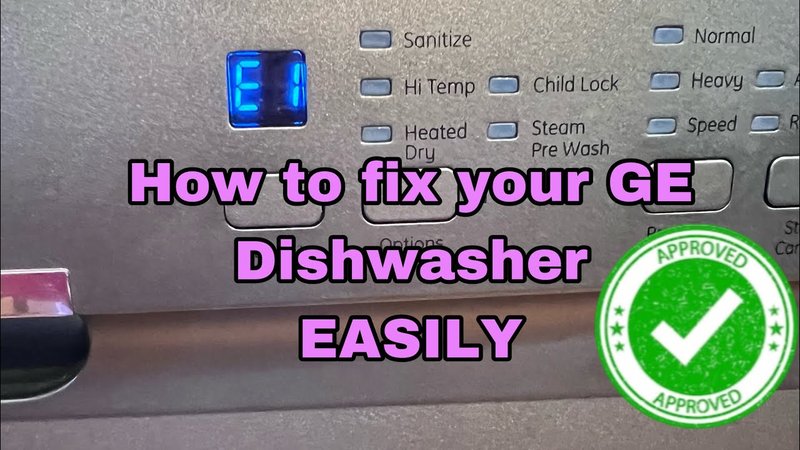
In this article, we’ll dive into what this error means, why it might be happening, and whether simply resetting your dishwasher might do the trick. We’ll walk you through this step-by-step, so if you’re a complete beginner, you’ll have no trouble following along. Hopefully, by the end of this, your GE dishwasher will be back to its sparkling best without a hitch!
Understanding the GE Dishwasher Error Code LE
So, you’re seeing an error code LE on your GE dishwasher. What does it really mean? Think of it this way: Your dishwasher is like a vigilant guard, on the lookout for any sign of water leaks. The error code LE stands for “Leak Error.” When your dishwasher senses what could be a leak, it triggers this code as a precaution. It’s like a concerned friend who spots a dripping tap and alerts you before there’s a flood.
Why does this happen? Well, there are a few common culprits. Sometimes it’s because the dishwasher detects moisture where there shouldn’t be any—like if a door seal has worn out or a pipe has come loose. Other times, it might be due to something as simple as an overly enthusiastic spray arm that’s gotten a bit out of control during the wash cycle. Either way, your dishwasher is essentially telling you, “I need a bit of TLC to make sure everything’s A-OK.”
What happens if you ignore this warning? While the error itself might just seem like an annoying interruption, ignoring it could result in more significant issues down the line, like water damage to your kitchen floor or even the inner workings of your appliance. Just like how a tiny crack in a windshield can spread, a small leak can lead to bigger problems if not addressed. But let’s not get ahead of ourselves—let’s see if a simple reset might do the trick!
How to Reset Your GE Dishwasher
You might be thinking, “Can a simple reset really fix the LE error?” It’s a bit like rebooting your computer when it’s acting up. Sometimes, a fresh start is just what the doctor ordered. The reset not only clears the error code but can also help recalibrate the sensors, allowing the dishwasher to reassess the situation.
To reset your GE dishwasher, start by turning off the power. This can typically be done by unplugging the unit from the wall or flipping the switch on your circuit breaker panel. Wait for about one minute—think of this as letting your appliance take a little nap. Afterward, turn the power back on. The dishwasher will reboot, and it’s now time to see if it still detects the potential water leak.
If the error code LE disappears, great! You might want to run a test cycle without dishes just to be sure everything’s running smoothly. However, if the error persists, it might be time to roll up your sleeves and look a bit further. But don’t worry, I’ve got you covered in the next section.
Steps to Troubleshoot Persistent Error Code LE
If resetting didn’t do the trick and the LE code stubbornly remains, it’s time to play detective. First, inspect the door seal closely. The door seal is akin to the rubber lining on your car door—when it wears out, leaks are inevitable. Look for any cracks or misalignments; even the slightest gap can trigger an error.
Next, check the float switch. This is a tiny device that juts up when the water level is correct and drops when there’s too much or too little water—it’s a bit like a lifeguard for your dishwasher. If it’s stuck or malfunctioning, it might be time for a replacement. Don’t worry, replacements aren’t too expensive or difficult to handle.
Finally, check the water inlet valve. This part is the gatekeeper for the water entering your dishwasher. If it’s clogged, it’s like a half-open faucet, causing water to spill more than it should. You’ll want to ensure it’s not blocked or damaged. If after all these checks the error still pops up, it could be time to call in the pros—sometimes the issue lies deeper than a home fix can manage.
Preventive Tips to Avoid Future Errors
Now that you’ve tackled the GE dishwasher LE error, let’s talk prevention. Just like changing the oil in your car keeps it purring, a bit of regular maintenance can prevent future dishwasher hiccups. First off, routinely check and clean the door seals. This ensures they remain supple and secure, preventing leaks.
Make sure the dishwasher isn’t overfilled during washes. An overcrowded dishwasher can cause water to splash around in unintended places, potentially triggering that pesky LE code. Imagine trying to stuff too many clothes into a washing machine and expecting it to run smoothly—it simply doesn’t work.
Lastly, it’s a good idea to run a maintenance cycle every once in a while. This is often a cycle where you run the dishwasher on empty, perhaps with a dishwasher cleaning agent, to flush out any residue build-up. It’s sort of like taking your car out for a nice long drive to clear out the cobwebs.
By staying on top of these tips, your GE dishwasher will be more likely to run smoothly and error-free. And should the LE code show up again, you’ll be well-equipped to deal with it swiftly and effectively!